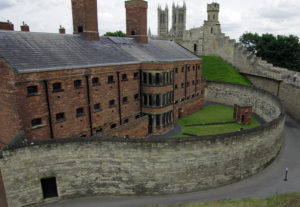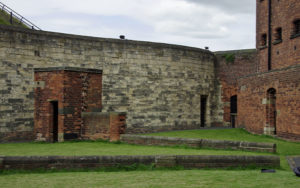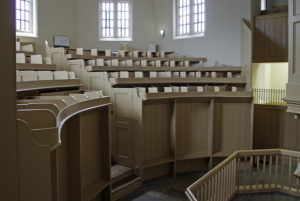There has always been a prison in Lincoln Castle but there are no visible traces of the early buildings. The brick Georgian Prison dates from 1788 and now has the ticket office, shop and “cafe.”:http://www.silvertraveladvisor.com/review/restaurant/165289-review-langtons-cafe-at-lincoln-castle It is a long narrow T shaped building. It held both felons and debtors. The prison governor lived there in an apartment with his family.
The Penal Reform Movement of the mid C19th found the Georgian Prison to be wanting and a new Victorian block was added behind it with separate blocks for men and women prisoners and a prison chapel. Exercise or airing yards were provided.
The men’s airing yards were at the back of the prison and were overlooked by the Head Warder’s rooms. The women’s airing yards were between in the Victorian and Georgian prisons and overlooked by the Matron’s rooms. Each had a small brick built toilet block and were separated by high walls.
The Georgian prison continued to be the debtors prison. The Victorian prison served as a ‘holding’ centre for male, female and child prisoners awaiting trial. Once convicted, they were sent elsewhere to serve their sentence. While in prison they received religious instruction from the prison chaplain and were given lessons in reading and writing.
The prison was designed on the ‘Separate System’ regime, with a head warder was in charge of the mens’ prison and a matron the women’s prison. Both had their own quarters and were not allowed to leave the building without permission. The system was designed to keep prisoners in a single cell and in isolation away from the corrupting influences of other prisoners with the intention to encourage their rehabilitation. It was hoped this would encourage them to reflect, repent and reform. Prisoners were not allowed to talk to each other, or to the warders. They were only allowed out singly into the exercise yards which had tall walls between them. If there was more than one prisoner in a yard then they had to wear masks over head so couldn’t see each other and were also chained so they couldn’t get close enough to talk.
The system proved unpopular with the gaolers who were not allowed to communicate with the prisoners and did not know their name or their crime. The isolation also sent many of the prisoners mad as they were reduced to numbers with their name, face and past history eliminated. It was later replaced with two or three inmates per cell.
The prison was on three floors with cells round the outside of a central atrium. The men’s and women’s prisons were separated by a large stair well. Large windows at the ends let in plenty of light.
A few cells in in the mens’ prison are furnished. These had hammock beds suspended between hooks on the walls, which could be folded up during the day. Each room had a toilet, basin with running water, gas light and a table. There was a small window set high on the wall with frosted glass preventing the prisoners from seeing outside.
The other cells are either empty of have assorted activities like peg rug making and games. There is even a dressing up room. Two are furnished as “Discovery Cells’ with washing or Oakum picking. Rope was cut into short lengths and had to be pulled apart by hand. The loose fibres or oakum were used for caulking ships or making mats.
On the lower floor are the windowless ‘Dark Cells’ used to punish prisoners.
The prison employed a surgeon who regularly checked the prisoner’s health, diet and living conditions. He prescribed medicines, leeches, poultices and ointments for sick prisoners. For certain ailments and diseases he might prescribe rest, extra food, additional clothing and exercise in the airing yard. On his orders, very sick prisoners could be sent to the Infirmary next to the Matron’s room in the Women’s Prison. Prisoners from poor backgrounds often got better medical attention here than they did outside.
The women’s prison is like the men’s prison but has fewer cells.
The Matron worked long hours and was responsible for maintaining discipline as well as looking after women and girls who were sick, mentally disturbed or who had given birth. The prison infirmary was next to her rooms. She also had teaching duties and was responsible for the prison laundry. Their cells were similar to the mens although expectant or nursing mothers were given a chair with arms rather than a stool. Straw baskets were placed by the mother’s hammock for their baby. Nursing mothers allowed to keep their babies with them until they were weaned, when they were taken to the workhouse to be looked after.
Many of the female prisoners were young unmarried servants. A common crime was the concealment of a birth and the secret disposal of the newborn baby’s body. Some were accused of infanticide. Other crimes included theft, robbery and arson. Their day was divided between cleaning the women’s prison, washing clothes in the prison laundry and attending chapel. They were also given religious instruction and taught how to read and write.
The cells now contain an exhibition of finds found during recent renovation of castle. These include pieces of Roman wall plaster, tesserae, coins, and jewellery. Medieval finds include coins, arrow heads, comb, padlock and key. C17th-C19th finds include a sundial, toothbrush heads, foot bath, clay pipes and a perfume flask. There is also the C10th stone sarcophagus which was found on the site of an early chapel.
All prisoners except Roman Catholics, the sick or nursing mothers with small babies attended daily prayers and two services on Sunday in the chapel. Many prisoners looked forward to chapel as it relieved the monotony of their day.
This is the only example of a Separate System Chapel to exist in the world. The prisoners were enclosed in wooden box like cells, separated from each other by a locked door. They were unable to see or communicate with their neighbours and could only see the prison chaplain in his pulpit. The chaplain could look down on everyone.
The women prisoners sat on benches at the front. The debtors sat on a bench at the back, screened from the prisoners by a curtain.
The prison closed in 1878 from expensive running costs and declining prisoner numbers. It was replaced by a new prison in Lincoln which is still in use today.
This is a fascinating place and well worth visiting, especially the chapel.
There are more pictures “here.”:http://wasleys.org.uk/eleanor/castles/england/midlands_south/lincoln_castle/index.html










